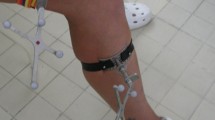Abstract
Purpose
Based on biomechanical cadaver studies, anatomical double-bundle reconstruction of the anterior cruciate ligament (ACL) was introduced to achieve better stability in the knee, particularly in respect of rotatory loads. Previously, the success of ACL reconstruction was believed to be mainly dependent on correct positioning of the graft, irrespective of the number of bundles for which computer-assisted surgery was developed to avoid malpositioning of the tunnel. The aim of this study was to compare rotational and translational stability after computer-navigated standard single-bundle and anatomical double-bundle ACL reconstruction.
Methods
The authors investigated 42 consecutive patients who had undergone the single-bundle or double-bundle ACL reconstruction procedure using autogenous hamstring tendon grafts and ENDOBUTTON fixation in patients who had been followed up for a minimum of 24 months. Post-operative anteroposterior and rotational laxity was measured with the KT3000 and compared between groups.
Results
Both surgical procedures significantly improve rotational and translational stability compared to the preoperative ACL-deficient knee (P<0.05). No significant differences were registered between groups with regard to anteroposterior displacement of the tibia. The International Knee Documentation Committee (IKDC) and Lysholm scores were significantly higher in the double-bundle group. However, the results were excellent in both groups.
Conclusions
The use of computer-assisted ACL reconstruction, which is a highly accurate method of graft placement, could be useful for inexperienced surgeons to avoid malposition. Long-term results of at least five years are needed to determine whether double-bundle ACL reconstruction, which was associated with improved rotational laxity and significantly better IKDC and Lysholm scores compared to the standard single-bundle ACL reconstruction procedure, exerts an influence in terms of avoiding osteoarthritis or meniscus degeneration.


Similar content being viewed by others
References
Aglietti P, Giron F, Buzzi R et al (2004) Anterior cruciate ligament reconstruction: bone-patellar tendon-bone compared with double semitendinosus and gracilis tendon grafts. A prospective randomized clinical trial. J Bone Joint Surg Am 86:2143–2155
Gabriel MT, Wong EK, Woo SL et al (2004) Distribution of in situ forces in the anterior cruciate ligament in response to rotatory loads. J Orthop Res 22:85–89
Aglietti P, Giron F, Cuomo P et al (2007) Single- and double-incision double-bundle ACL reconstruction. Clin Orthop Relat Res 454:108–113
Meredick RB, Vance KJ, Appleby D et al (2008) Outcome of single-bundle versus double-bundle reconstruction of the anterior cruciate ligament: a meta-analysis. Am J Sports Med 36:1414–1421
Amis A, Bull AMJ, Lie DT (2005) Biomechanics of rotational instability and anatomic anterior cruciate ligament reconstruction. Oper Tech Orthop 15:29–35
Hefti F, Müller W (1993) Current state of evaluation of knee ligament lesions. The new IKDC knee evaluation form. Orthopade 22:351–362
Lysholm J, Gillquist J (1982) Evaluation of knee ligament surgery results with special emphasis on use of a scoring scale. Am J Sports Med 10:150–153
Tegner Y, Lysholm J (1985) Rating systems in the evaluation of knee ligament injuries. Clin Orthop Relat Res 198:43–49
Daniel DM, Stone ML, Dobson BE et al (1994) Fate of the ACL-injured patient. A prospective outcome study. Am J Sports Med 22:632–644
George MS, Dunn WR, Spindler KP (2006) Current concepts review: revision anterior cruciate ligament reconstruction. Am J Sports Med 34:2026–2037
Laxdal G, Kartus J, Hansson L et al (2005) A prospective randomized comparison of bone-patellar tendon-bone and hamstring grafts for anterior cruciate ligament reconstruction. Arthroscopy 21:34–42
Lopomo N, Zaffagnini S, Bignozzi S et al (2010) Pivot-shift test: analysis and quantification of knee laxity parameters using a navigation system. J Orthop Res 28:164–169
Yagi M, Kuroda R, Nagamune K et al (2007) Double-bundle ACL reconstruction can improve rotational stability. Clin Orthop Relat Res 454:100–107
Ferretti A, Conteduca F, De Carli A et al (1991) Osteoarthritis of the knee after ACL reconstruction. Int Orthop 15(4):367–371
Mae T, Shino K, Miyama T et al (2001) Single- versus two-femoral socket anterior cruciate ligament reconstruction technique: biomechanical analysis using a robotic simulator. Arthroscopy 17:708–716
Yagi M, Wong EK, Kanamori A et al (2002) Biochemical analysis of an anterior cruciate ligament reconstruction. Am J Sports Med 30:660–666
Marcacci M, Molgora AP, Zaffagnini S et al (2003) Anatomic double-bundle anterior cruciate ligament reconstruction with hamstrings. Arthroscopy 19:540–546
Domzalsk M, Grzelak P, Gabos P (2010) Risk factors for anterior cruciate ligament injury in skeletally immature patients: analysis of intercondylar notch width using magnetic resonance imaging. Int Orthop 34(5):703–707
Legnani C, Ventura A, Terzaghi C et al (2010) Anterior cruciate ligament reconstruction with synthetic grafts. A review of literature. Int Orthop 34(4):465–471
Kodali P, Yang S, Koh J (2008) Computer-assisted surgery for anterior cruciate ligament reconstruction. Sports Med Arthrosc 16:67–76
Picard F, DiGioia AM, Moody J et al (2001) Accuracy in tunnel placement for ACL reconstruction. Comparison of traditional arthroscopic and computer-assisted navigation techniques. Comput Aided Surg 6:279–289
Colombet P, Robinson J, Christel P et al (2007) Using navigation to measure rotation kinematics during ACL reconstruction. Clin Orthop Relat Res 454:59–65
Araki D, Kuroda R, Kubo S et al (2011) A prospective randomised study of anatomical single-bundle versus double-bundle anterior cruciate ligament reconstruction: quantitative evaluation using an electromagnetic measurement system. Int Orthop 35(3):439–446
Acknowledgment
This study received financial support from the Emerging Scientist Project of Shenzhen Second People’s Hospital and the Guangdong Province Medical Research Fund (the project number is B2012320) and Guangdong Province outstanding youth innovative talent training program (Seedling project, the project number is 2012LYM_0120).
Author information
Authors and Affiliations
Corresponding authors
Rights and permissions
About this article
Cite this article
Zhu, W., Lu, W., Han, Y. et al. Application of a computerised navigation technique to assist arthroscopic anterior cruciate ligament reconstruction. International Orthopaedics (SICOT) 37, 233–238 (2013). https://doi.org/10.1007/s00264-012-1764-6
Received:
Accepted:
Published:
Issue Date:
DOI: https://doi.org/10.1007/s00264-012-1764-6




